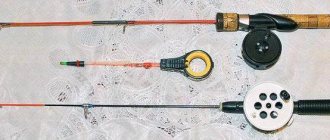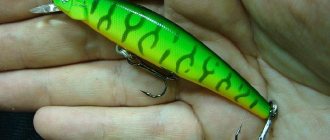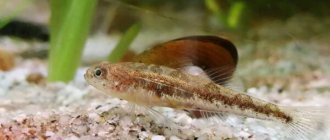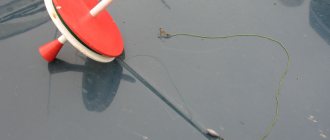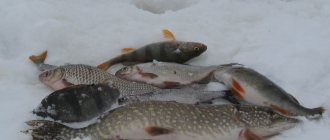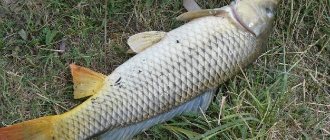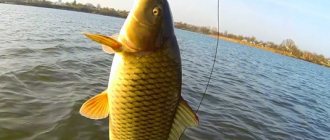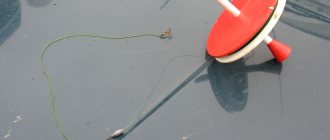Mugs are floating tackle for catching predatory fish (pike, pike perch, perch) with live bait. This tackle is very catchy both in terms of quantity and quality of fish caught.
The most widespread among fishermen are mugs in the form of a foam plastic disc, although mugs can also be made from wood, a plastic bottle, or a tin can.
What does the tackle look like?
- A disc with a diameter of 13 to 18 cm made of light material, with a thickness of 2 to 3 cm; smaller ones are less commonly used for catching perch. A groove about 10 mm deep is selected along the perimeter of the disk, into which fishing line or nylon thread is wound. In the center there is a hole with a diameter of 10-15 mm for the antenna.
- The antenna or mast, which is inserted into the central hole of the circle, is 15 to 18 cm long with a thickening at one end and a slot at the other.
Homemade circle for pike
There are a large number of homemade mugs; as a rule, each fisherman makes them for himself. Conventionally, they can be divided into classic ones with an antenna and less popular ones without pins.
There are also such unique designs as mugs made from a plastic bottle or tin can. It’s hard to say which circle is better; it all depends on the angler’s habits, conditions and fishing location.
Optimal sizes
As mentioned above, the optimal size of the circle is from 13 to 18 cm, but not everything is so simple here, it all depends on what kind of fish to catch and what size of live bait will be used. Also, the size of the mug depends on the material from which it is made. Mugs that are made from cork or foam are smaller in size than wooden ones and rarely exceed 13 cm in diameter.
If you are going to catch trophy specimens of pike, then the diameter of the circle should be within 18-20 cm. The thickness of the circle does not depend on the material and rarely exceeds 3 cm.
The process of making a tackle-mug with your own hands
In principle, making a circle with your own hands will not be difficult. If you make a circle from foam plastic, you will need a utility knife, drill, file, sandpaper, and red or orange paint.
To make a mug from wood, it is better to use a lathe; this will make the work much easier and the mug will have a neat appearance.
Materials for making a mug
Any materials with good buoyancy are suitable for making a mug disk; as a rule, these are cork, polystyrene foam, wood, and plastic. Each material has both its advantages and disadvantages.
Mugs made from lighter materials (cork, polystyrene) are easy to process, but at the same time they are quite fragile and will not last long. They also float excessively and in strong winds on a pond, it will be difficult for you to keep track of them.
Making mugs from wood is a more labor-intensive process, but the service life of such mugs, if processed correctly, will be longer. They are also a little heavier than foam or cork and won't blow around as easily.
Less traditional materials, such as a tin can or plastic bottle, can also be used to make mugs.
Making a mug
Let's consider the option of making a traditional pin circle from extruded polystyrene foam, it is also called penoplex, this material can be bought at any construction supermarket
- First you need to mark a sheet of foam plastic, for this it is convenient to use a CD, it has a suitable diameter of 12 cm, and it also has a hole in the middle.
- The next step will be cutting out the round blanks. To cut out circles, it is better to use a sharp stationery knife or jigsaw.
- The third stage is more labor-intensive and involves cutting a groove into which the fishing line or cord will be wound. For these purposes, it is also convenient to use the same knife and a round or triangular file. A hole in the disk is drilled slightly smaller than the diameter of the peg. Two cuts are made along the edges of the circle, on opposite sides. There is a very important nuance: the cuts should not reach the very groove for the fishing line. If the cut is made larger, this will lead to an increase in empty turns, and if the fishing line gets caught in the cuts, it will not reel in and the pike, feeling resistance, will spit out the bait.
- After the disk has been cut out and all the holes and grooves have been made in it, it is sanded with fine sandpaper, all sharp edges are smoothed out, and the top part is painted with bright waterproof paint.
The process of making mugs from wood is, in principle, no different from making mugs from foam plastic. It is better to cut a circle from linden; it is easy to process and has good buoyancy.
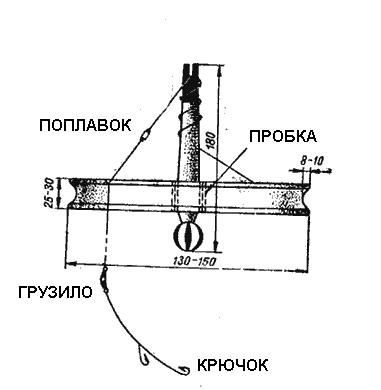
It is more convenient to cut and process the circle on a lathe. The wooden circle is subject to more careful processing. After sanding, the circle must be soaked in drying oil and puttied.
It is better to use a two-component putty based on tsapan varnish and BF2 glue. When the circle dries, it needs to be sanded again with sandpaper and painted. The paint can be used either nitro or oil based.
The upper part of the disk, which is above the water, is painted in a bright color, most often red or orange, and the lower part is covered with white paint.
For circles that are made of wood, you need to insert a cork insert into the middle of the hole for the mast, this will increase the clamping force of the latter.
To avoid excessive buoyancy of foam circles, some fishermen resort to this trick: a saucer-shaped recess is made in the middle of the circle and during windy weather it is filled with water; under its weight, the circle sinks more into the water and sails less.
Materials for making a mast
A mast is inserted into the hole in the circle. Wood (pine, spruce) or plastic is used to make the mast. Some fishermen use a metal-plastic pipe with a diameter of 10 mm as a mast.
Making a mast
The size of the stick is tied to the diameter of the circle itself. If the mast is made of wood, it has a cone-shaped shape, the length of the mast is in the range of 15-18 cm, at the lower end, which will be under water, a spherical thickening with a diameter of 2.5-3 cm is made.
In the upper part, a cut is made up to 2 cm deep, into which the fishing line will be inserted. The middle part of the mast is painted white, and the upper part with the cut is black, this combination of colors makes the circle more noticeable.
The lower spherical part is painted half white and black; this coloring helps to distinguish whether the circle rotates after a bite or not. The mast not only acts as a regulator of the stability of the circle and facilitates its turning over, but also with the length of the stick you can regulate the course of the circle and reduce the number of idle bites or unauthorized turning of the circle due to gusts of wind.
What does a circle represent?
A circle is a small fishing tackle, used mainly for pike. According to the law, you can use five pieces; more is poaching.
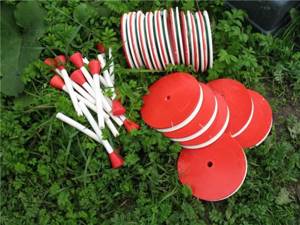
Fishing with mugs is welcome on a reservoir with at least some current
It looks like a circle with a small mast in the center, painted red and white. You can buy it in the store, but it’s not difficult to make it yourself.
Factory-made tackle is almost never in demand. It is made entirely of hollow plastic, the pin can be either removable or connected to a circle. It is considered a replacement for a regular mug, but experienced fishermen prefer self-made things.
This thing is also called a floating vent. It does not depend on the fisherman and moves through the water independently. Live bait is used as bait.
The main advantage of the circle is that it allows you to fish where other gear would be useless, that is:
- Far from the coast.
- In the reeds and reeds.
- Over snags and driftwood.
- In the rubble.
The device does not require control by the fisherman, and it often happens that it swims to the right places on its own.
Equipment mug
The equipment includes the following elements:
- fishing line (monofilament or nylon braid);
- sliding sinker weighing up to 15 g;
- carbine with swivel;
- leash (steel, titanium, fluorocarbon);
- hook (single, double or tee).
fishing line
To equip a circle, either monofilament or braided or twisted nylon thread can be used as the main fishing line. The main criteria that a fishing line must meet are strength and stealth; the fishing line must withstand a dead weight of at least 5 kg.
According to many fishermen, it is better to use a nylon thread with a thickness of about 2 mm on mugs. The thread or fishing line should have an inconspicuous color, usually green or brown. Also, this color will be clearly visible on the mug, which is very important, as it can inform the fisherman whether the cord is wound or not after a bite.
The thread is attached to the circle with an ordinary noose. The length of the cord should exceed the depth of the reservoir by 3-4 m; there is no need to leave a large margin, otherwise it may lead to tangling. If the depth of the reservoir turns out to be small, then you can limit the supply of the cord with a double loop.
Sinkers
Sinkers are used to hold live bait at a certain depth. The usual weight of the sinker is 10-15 grams, it is better when it has the shape of an olive. There is no need to secure the sinker tightly to the fishing line; it should slide freely; a stopper is installed at a height of 10-15 cm from the leash.
Leash
To protect the fishing line from the teeth of the pike, use a leash no longer than 30-35. Previously, steel leads were used, which were made from guitar string No. 1 or No. 2, but now new materials such as tungsten, titanium, etc., have appeared on sale.
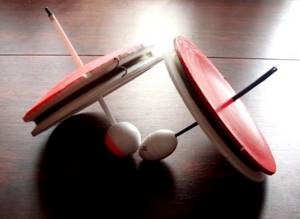
But from personal experience and in the opinion of most fishermen, a fluorocarbon leash with a thickness of at least 0.6 mm gives a good result; if it is thinner, the pike can cut it off. cm. This material is flexible, it does not hinder the movement of live bait and is completely invisible in the water; you can also use nylon fishing line, but the result will be worse.
The leash is attached to the main line using a swivel with a carabiner so that it can be easily replaced. A clasp is attached to the end of the leash for quick replacement of the hook. You need to tie the carabiner and swivel using a clinch knot.
Hook
When catching pike with circles, both single, double and triple hooks are used; there is no consensus on which one is better, it all depends on the fishing technique.
If a fisherman has the opportunity to quickly approach like a triggered mug and hook in time, then you can use treble hooks, but if you fish by letting the pike swallow the bait, then double and single hooks are suitable, but the latter technique is used when fishing with girders.
The size of the hook is selected according to the size of the live bait; the larger the bait, the larger the hook. The most popular numbers for tees are 5-12 for single hooks 6-14. In practice, a method that has proven itself well is when two single hooks are used, one hook clings to the lip of the baitfish, the other is pierced under the dorsal fin, in its lower part.
Nozzle
Small fish - live bait - are used as bait. The best species of fish are those that inhabit the body of water in which you plan to fish. However, it is impossible to say unequivocally that pike will be caught with this particular bait, but we can say with confidence that in most cases it prefers it. When choosing live bait, the time of year also plays an important role; in the summer, pike prefers crucian carp, in the fall, roach and perch.
The main fish species used as live bait are:
- crucian carp;
- roach;
- gudgeon;
- bleak;
- ruff.
If we take into account the survivability and preference of pike, then the best live bait are considered to be crucian carp and gudgeon; roach is also highly valued by the predator, but it quickly falls asleep and is poorly stored, and also tries to constantly float to the surface, which is what confuses the tackle.
Bleak is a more seasonal fish and very delicate, suitable for fishing in spring and autumn. Pike takes ruff or perch less readily, but in reservoirs where these fish species are the main food supply, it grabs them greedily.
Video
Summer pike fishing with mugs video
PIKE FOR MUGS AND LARGE PERCH!
Watch the video of catching pike with mugs in the fall
Fishing. Catching Pike with Mugs (Stands) The Most Catchable Tackle.
Catching pike with mugs on the lake video
Pike for mugs."Our Fishing" film No. 13. Video courtesy of Boris Saxonov. The film was shot as part of the project - Our Fishing and is dedicated to catching pike with mugs. Filmed at the end of November. Filming took place on the Dnieper, in the area of a high dam.
DIY mugs for pike from a bottle
This type of circles has not found wide application, but has the right to life.
Making such a circle will not be difficult; here is the procedure for preparing such a circle:
- A fishing line or braided thread is tied to the neck of a plastic bottle with a capacity of at least 0.5 liters, preferably one that already has a narrowing in the middle, and is wound around the bottle. The length is selected according to the same principle as in classic mugs.
- The mug is being rigged (sinker, hook leash)
- After the bait is hooked and lowered into the water to the required depth, the fishing line is fixed to the bottle by inserting several loops under a rubber ring. That's it, our gear works. After the bite occurs, the pike will pull the line out from under the rubber ring and begin to reel it in; as soon as all the line is reeled in, the bottle will rise upside down. In order to make the bite more noticeable, it is better to paint the bottom of the bottle (in our case, the bottom) in a bright color with waterproof paint.
The mugs used for pike fishing must be the same size, especially in thickness. For ease of transportation and storage of mugs, the mast does not need to be tightly attached to the mug. And we must remember that the success of pike fishing depends on many factors, including knowledge of the reservoir, the ability to choose the right tackle and bait, as well as the personal qualities of the fisherman.
Installation of circles
So, you have made your gear and chosen a place where you will catch pike. Now you need to install fishing mugs .
Each angler is allowed to have a maximum of five fishing gear. If you fish with someone else in the same boat, you can use 10 tackles.
Take the circle and wind the cord from it. The length should be such that the bait is at a depth of half a meter to one and a half meters from the bottom. Now we attach a small float made of cork to the end. We insert the cord into special cuts on the outside of the circles. Wrap the cord around the pin a couple of times. We attach bait and lower this structure into the water. The distance between circles should be from 5 to 10 meters. You need to monitor the tackle from a distance so as not to spook the fish, and, at the same time, not to lose sight of the mugs. It's best to just have them follow the boat.
If the current is strong, then it is better to anchor the tackle , otherwise they will simply be carried away. A fishing line is used as anchors, which is tied with one ring to a pin, and the other to thickets and bushes. If there are no thickets, then they take a stick and tie a cord weighted with a weight to it, and the other end of the stick is attached to the thickest part of the pin.
If a pike pecks at your bait, the circle first turns over with its white side up, and then rotates, and the fishing line unwinds. When the movements stop, it means the fish has taken the bait. After which the circle begins to rotate again, which means that the pike is trying to go into cover. At this moment you need to drag it into the boat, pulling up the fishing line, and help yourself with the hook.
